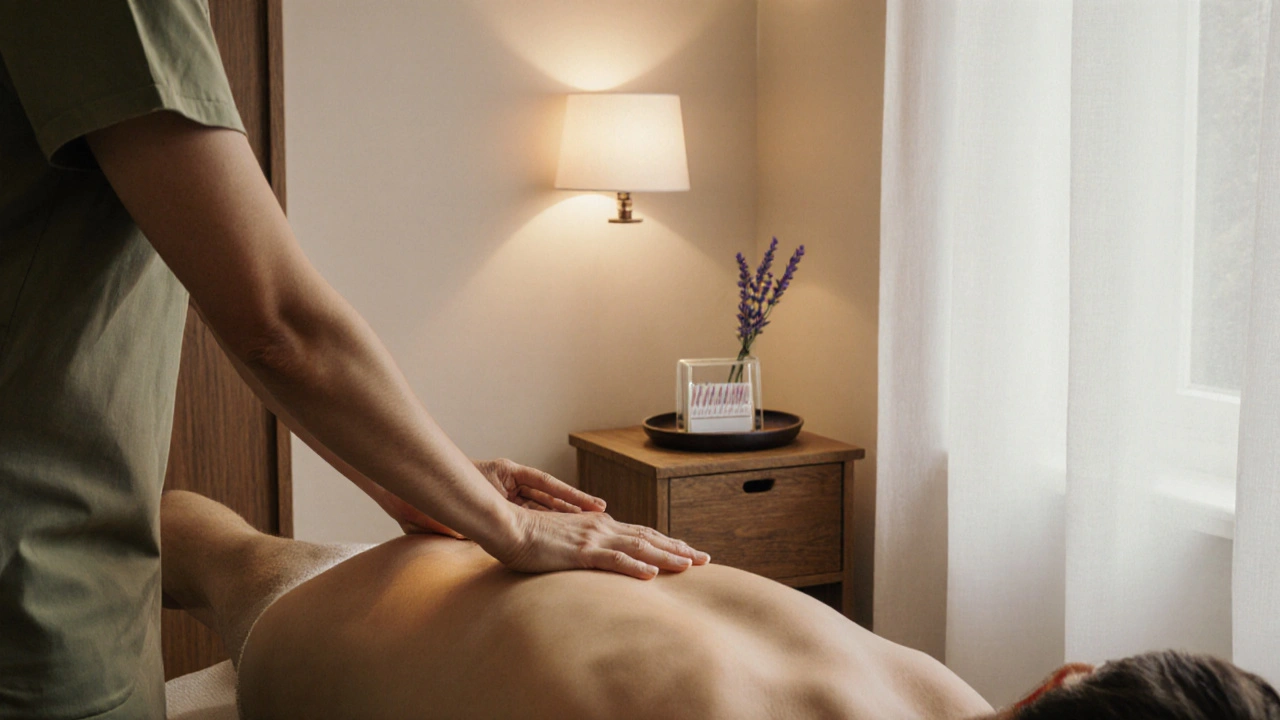Discover how Swedish massage and acupuncture work together to boost relaxation, pain relief, and overall wellness. Learn benefits, pricing, safety tips, and how to find combined therapy services in London.

- Created by: Liam Redgate
- Completed on: 23 Jul 2025
- Categories: Massage London
Ever noticed how everyone has a strong opinion about massage? My sister swears by Swedish for her anxiety, but my mate Rob walks out of a deep tissue session waving his arms like he just ran a marathon. It's not just hype—there are real reasons these two classic massages spark such die-hard loyalty. If you've never tried either, or maybe you’re stuck choosing between a gentle fix and a muscle mash, it’s worth getting clear on what sets these techniques apart, why people trust them, and when each one actually shines.
Key Takeaways: Swedish vs. Deep Tissue Massage
- Swedish massage: Gentle, relaxing; focuses on soothing the whole body and relieving minor tension.
- Deep tissue massage: Intense, slow pressure; targets deep muscle knots and chronic pain.
- Both techniques boost circulation and mood, but the experience—and results—are very different.
- London spas offer both, often with options for extras like aromatherapy or hot stones.
- Choose Swedish if you crave general relaxation; pick deep tissue if you’ve got specific aches and chronic tension.
Direct Answer: Which Massage Should You Choose?
If you want a mellow session that wipes away everyday stress and leaves you chilled out, Swedish massage is where it’s at. Need to tackle stubborn knots from workouts, bad posture, or chronic pain? Then deep tissue is your best bet. People dealing with sports injuries, sciatica pain, or serious muscle tightness usually go straight for deep tissue. For everyone else—especially first-timers or those seeking pampering—Swedish massage is a classic for good reason.
Understanding Swedish and Deep Tissue Massage: The Essentials
Massage isn’t a luxury for the rich or a secret treat for only the stressed-out. In London, a city with everything from marathon runners to exhausted parents (I’m definitely in the latter category thanks to my son, Soren), getting massage therapy has become part of everyday self-care. But what actually happens in these two most popular massage sessions?
Swedish massage uses long, flowing strokes, gentle kneading, and rhythmic tapping. Therapists focus on relaxing the superficial layers of muscles, boosting blood flow, and encouraging your body’s natural chill-out mode. Everything is slower, lighter, and meant to calm. Think of it like a slow walk in Hyde Park after a long week—restorative, not strenuous.
Deep tissue massage, on the other hand, dials up the intensity. You’ll get firm, focused, and sometimes downright strong pressure that aims to break up adhesions, realign muscle fibers, and resolve deep-seated pain points. The therapist uses fingers, elbows, sometimes even forearms to dig into trouble spots. This isn’t a walk in the park; it’s more like climbing Primrose Hill with a toddler on your back. The release afterward is real, though, and research backs it: a 2024 Nuffield Health study showed 68% of regular deep tissue clients reported significant reduction in back pain after just 6 sessions.
Both types use oils to help hands glide smoothly, keep skin comfortable, and sometimes add a sensory perk—think eucalyptus or lavender—if you pick aromatherapy options.
So, why do people stick to one or the other? For most, it comes down to what their body needs: Swedish is a catch-all for anyone wanting to de-stress; deep tissue is for those who feel tension so deep it keeps them up at night.
Swedish Massage vs. Deep Tissue: Detailed Benefits Explained
Let’s break it down so you can see which therapy matches your goals.
Swedish massage is ideal for unwinding, easing anxiety, and promoting circulation. People rave about sleeping better and feeling lighter in spirit after just 60 minutes on the table. Some London therapists even include a mini scalp massage (an absolute game-changer if you’re tense from screen time). Top benefits include:
- Stress reduction—A 2023 study from King’s College London found cortisol (stress hormone) levels dropped by 17% after a single Swedish session.
- Improved flexibility—Those long gliding strokes help loosen up joints, so you’re less creaky after a day hunched over your laptop.
- Enhanced blood flow—Some folks actually walk out looking like they’ve napped for days, their skin glowing.
- Pain relief for tension headaches and minor muscle aches.
- Mood boost—Triggering oxytocin and serotonin, those feel-good brain chemicals.
Deep tissue’s magic lies in tackling chronic pain. If you train hard, slouch at your desk, or simply have knots as solid as granite, this is where you finally get lasting relief.
- Reduces muscle knots—A prime benefit for runners and cyclists in London’s active scene.
- Breaks down scar tissue—Especially important for people recovering from injuries or surgery.
- Improves mobility—A survey with London physiotherapists in 2024 showed deep tissue helped 59% of back pain patients regain daily function faster than those relying only on stretching.
- Alleviates symptoms of chronic pain conditions like fibromyalgia or sciatica.
- Supports athletic performance—Many local footballers book deep tissue weekly as part of their recovery routine.
Around the city, lots of therapists now mix elements from both—it’s not rare to get a mostly Swedish massage with a few deep tissue techniques thrown in for your stubborn spots. Just ask before you start if you want a tailored approach.
Where to Find and Book Massage Services in London
Londoners have no shortage of options—seriously, there are massage clinics everywhere from Soho to Shoreditch, plus mobile therapists ready for home visits across Zone 1 and 2. Many spas let you pick Swedish or deep tissue as part of express lunch break deals or as longer, pampering escapes (I’ve even seen midnight bookings for the night owls among us).
Here’s what to look for when choosing your spot:
- Read reviews—Google and Trustpilot are your friends. Look for therapists who get high marks for skill and professionalism.
- Check qualifications—Legitamyterapists in the UK should have ITEC, VTCT, or similar qualifications. If you’re injury-prone or pregnant, make sure they have that experience under their belt.
- Local specialities—Neighborhoods like Covent Garden and Notting Hill host spas famous for luxurious Swedish treatments, while East London is packed with clinics focused on sports and deep tissue work.
- Extras—Lots of London spots bundle Swedish or deep tissue with aromatherapy, hot stone upgrades, or reflexology foot add-ons. If you want to make a day of it, go for a package.
Booking’s usually easy these days. Most spas and therapists offer instant online booking. Some even have loyalty cards or app deals (great for saving a few quid if you become a regular). Weekends fill up fastest, especially during sports season and winter months.
For the “do I need to bring anything?” types—just show up. Most places have everything ready (towels, oils, showers) and will ask you about preferences before your session starts.

What To Expect During a Massage Session in London
If you’ve never booked a massage in London, here’s the real scoop on what goes down. Swedish massage starts off with introductions, a chat about your stress levels, and maybe a gentle squeeze of your shoulders as you settle in. The therapist will dim the lights, play some mellow music, and ask how much pressure you prefer. Then it’s gentle, rhythmic motions across your whole body. You’ll get a mix of effleurage (gliding strokes), petrissage (kneading), and some tapotement (light tapping—think drumming fingers). Usually they start on your back, then legs, arms, sometimes scalp or face. At the end, you’ll feel floaty, not groggy.
Deep tissue’s process is similar at first—a good therapist will always ask about old injuries or trouble spots. Expect them to check in a few times about your comfort level. The pressure ramps up, sometimes feeling like a dull "hurts-so-good" ache. Therapists might focus on one area for longer, working out the knots inch by inch. You’ll probably feel a little sore afterward—like after a tough workout—but most people notice serious relief by the next day.
Sessions run 30, 60, or 90 minutes, but 60 minutes is the sweet spot for both types. A glass of water after is standard, since both massages encourage your body to flush out stress byproducts.
Don’t worry about being judged. Therapists have seen it all—stray body hair, weird tan lines, you name it. Come as you are! (If you’re self-conscious, keep underwear on; they’ll work around it with towels.)
Prices, Booking, and What You’re Really Paying For
Massage in London varies by location, therapist experience, and session length. Expect to pay between £45-£75 for a 60-minute Swedish or deep tissue massage at most clinics. Fancier spas charge £100+ for the luxury experience with extras like hot stone, essential oils, or customized music. Mobile therapists—who come direct to your door—are usually £60-£90, depending on travel time and supplies.
Many places run first-time deals (I got 20% off my last deep tissue at a new Dalston spot). Booking ahead is smartest; busy times like evenings and weekends fill up fast. Some apps let you compare prices across therapists, and flexible schedules will save you money if you can do off-peak hours.
You’re not just paying for hands-on time, but for expertise, convenience, and sometimes a next-level environment (think rainforest showers, herbal teas, and therapist who know exactly how to untie your knots). Tips aren’t mandatory in the UK, but most people add £5–£10 for great service.
| Type | Duration (min) | Avg. Cost | Extras |
|---|---|---|---|
| Swedish | 60 | £45–£75 | Hot towels, aromatherapy |
| Deep Tissue | 60 | £50–£80 | Sports focus, remedial add-ons |
| Mobile (Home) | 60 | £60–£90 | Travel, personalized |
| Luxury Spa | 60 | £95–£120 | Full amenities, bespoke oils |
Staying Safe and Getting the Most from Your Massage
You want relaxation, not surprise bruises or awkward moments. Here’s how to keep it safe:
- Be open about medical history—If you’ve had surgery, chronic illness, or recent injury, say so. A good therapist will adapt their technique (or refer you to someone with more experience).
- If it hurts—Speak up! There’s no bravado badge for toughing out excessive pain. Deep tissue can be firm, but it shouldn’t leave you gritting your teeth.
- Prego? Tell them! Lots of therapists are trained in pregnancy-safe techniques.
- Hydrate before and after—Massages help flush out metabolic waste (aka what builds up from everyday stress). Water helps speed recovery.
- If you have allergies to oils or lotions, let them know up front. Most London spots carry unscented alternatives.
- Trust your gut—If a spa or therapist feels sketchy, bail. There’s nothing wrong with walking out if something feels off.
Side note: If you’re shy about undressing, wear shorts and a top, or just keep your underwear. It’s absolutely fine. Therapists care about your comfort above all else.
Swedish vs. Deep Tissue: Quick Comparison Table
| Feature | Swedish Massage | Deep Tissue Massage |
|---|---|---|
| Pressure | Light to moderate | Moderate to deep |
| Main Focus | Relaxation, gentle muscle tension relief | Chronic pain, deep muscle release |
| Typical Duration | 30–90 minutes | 30–90 minutes |
| Pain/Discomfort | Minimal | Sometimes during tough spots |
| Best For | First-timers, stress relief, overall relaxation | Athletes, injury recovery, chronic pain |
| Recovery Time | None—feels instant | Might be sore up to 48 hours |
| Extras | Aromatherapy, facial add-ons | Sports taping, stretching |
FAQ: Your Questions About Swedish and Deep Tissue Massage in London
Q: Will deep tissue massage be painful?
A: It can feel intense, especially if you have stubborn knots, but it shouldn’t ever be so much that you want to jump off the table. Always tell your therapist to ease up if it’s too much.
Q: How do I know if I’m getting a real Swedish or deep tissue massage?
A: Ask about the therapist’s training. Swedish massage emphasizes long, flowing strokes, while deep tissue involves slower, more forceful work on deeper muscle layers. Check their qualifications and read recent reviews.
Q: Can I mix the types?
A: Yes, and lots of London therapists do just that. If you want relaxation with a bit of concentrated work on tight spots, just ask for a combo session.
Q: How often should I get a massage?
A: For most people, once a month is perfect for maintenance. If you’re dealing with chronic pain or athletic recovery, some go every week or two for a few months.
Q: Are massages safe for everyone?
A: Most adults can enjoy massage, but people with certain conditions—like contagious skin problems or recent injuries—should check with their doctor first.

Ready to Choose Your Perfect Massage?
Whether you’re craving a cloud-soft Swedish escape or serious muscle reboot with deep tissue, London probably has a therapist waiting for you. Take time to weigh what your body really needs—and don’t be afraid to try both and see what clicks. Want to know more or book the best local massage? Check out our guide to the top-rated spas in your neighborhood and unlock some real relaxation today.
Swedish massage is a perfect blend of relaxation and therapeutic benefits. This popular massage technique not only helps reduce stress and tension but also improves circulation and flexibility. Whether you're looking to unwind after a long week or need relief from sore muscles, Swedish massage is an excellent choice. Explore how this timeless method of relaxation can enhance overall well-being and learn what to expect during a session.
Swedish massage offers a powerful remedy for stress relief, providing a therapeutic blend of techniques to relax muscles and calm the mind. By focusing on gentle movements and tailored pressure, it enhances circulation and reduces tension, making it a favorite choice for those seeking peace amidst a hectic lifestyle. With benefits spanning improved physical health and mental well-being, Swedish massage stands out as a holistic treatment. Easily accessible and widely practiced, it’s a practical option for de-stressing. Discover how this classic technique can transform your relaxation routine.



